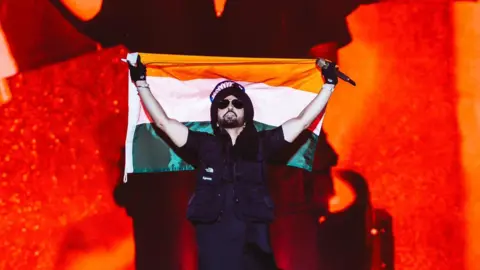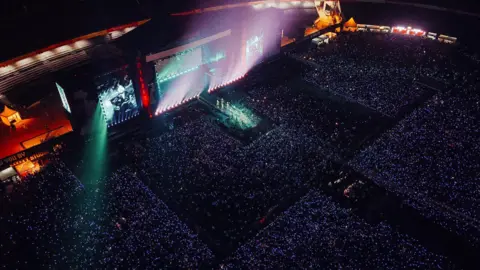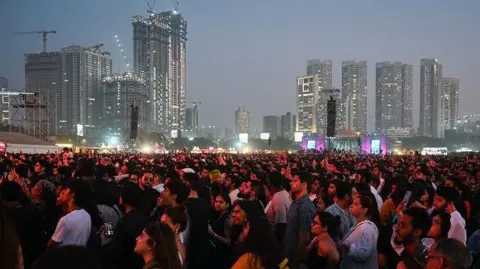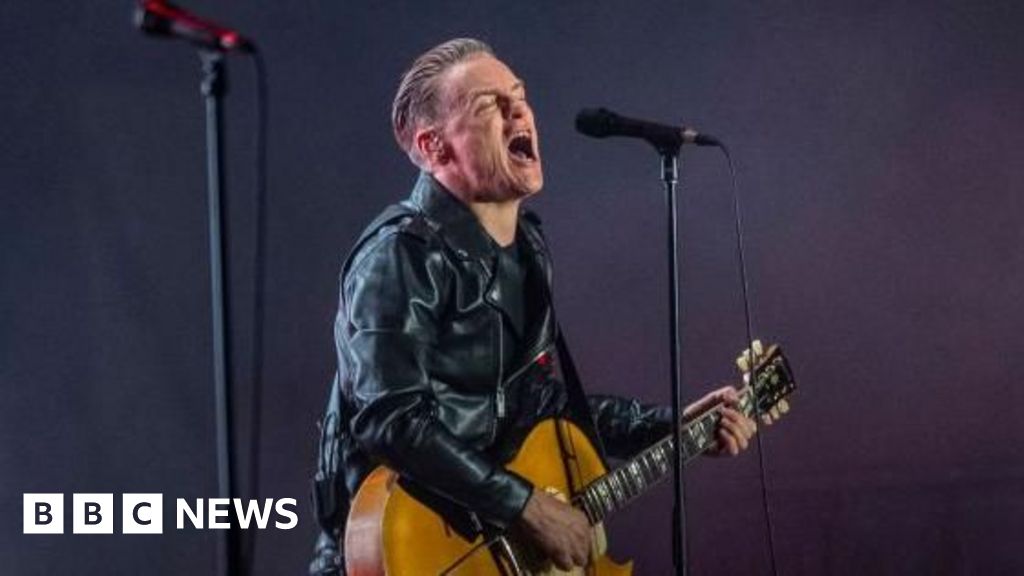 X/diljitdosanjh
X/diljitdosanjhWhen Amrita Kaur decided to attend Punjabi pop star Diljit Dosanjh’s concert in India this month, she was prepared to experience some discomfort.
Having attended several concerts in the past, Ms Kaur was sort of looking forward to the “exhilarating chaos” that comes with large crowds at big events in India.
But what awaited her was far worse than she had imagined.
Crowd control was minimal and sanitation non-existent. Overloaded mobile networks stopped working, sparking fears about personal safety. Even using the toilet felt like a gamble, she said, as it meant having to spend the rest of the performance queued up in front of “unhygienic, smelly cubicles”.
The venue, a massive piece of government-owned land in the northern city of Chandigarh, had no public transport connections or parking space, leaving Ms Kaur with no option but to drive her car to a friend’s nearby – and then get stuck in the inevitable, hours-long traffic jam once the concert had ended.
“You pay so much for a ticket and what do you get in return? A possible urinary infection and a bad headache with some bouts of music,” she says about her experience.
This year has been big for India’s burgeoning concert industry, with major tours by Dua Lipa, Dosanjh and Maroon 5 packing stadiums and grounds already thrilling audiences. Other international acts like Green Day, Coldplay and Ed Sheeran are set to perform in the coming months.
In fact, India’s music concerts generated about 8bn rupees ($94.1m; £75.3m) in revenue last year – a figure that is set to increase by 25% by the end of 2025.
Young, well-to-do Indians are not just willing to pay more to see their favourite music stars, but are actively seeking out these events. In 2023, more than 400,000 people in India said they travelled to other Indian cities to attend live events.
But despite the enthusiasm, many concertgoers say their experience has been far from ideal. The issue made headlines earlier this week, when a diabetic patient with incontinence issues said he ended up soiling himself at a Bryan Adams concert due to unavailability of washrooms at the venue.
On the same day, Dosanjh, who has been on a nationwide tour, shocked his fans by announcing that he wouldn’t perform in India again until the infrastructure at concert venues got better. The singer later clarified he was referring to only one of the venues.
 Getty Images
Getty ImagesSince then, social media has been awash with similar complaints from concertgoers. From booking tickets on dodgy scalping websites for astonishingly high prices, to braving hours-long traffic before and after a show, often on a full bladder, fans say they have to pay with more than just money to see their favourite acts.
Those who have the means are now opting to attend shows in other countries for a safer and generally more fun experience. “At Adele’s concert in Munich, the staff continuously cleaned the toilets and it was super clean even after a three-hour concert,” says Ishika Goon, a Bengaluru-based lawyer. “If I have to spend so much money, I might as well go for the full experience.”
Organisers and promoters acknowledge the problems but say they too are hobbled by wider infrastructural challenges.
That’s because India does not have enough venues dedicated to live concerts, forcing them to opt for suboptimal spaces or simply avoid certain cities altogether, all of which prevents the industry from scaling up, says Anmol Kukreja, the co-founder of Skillbox, a live entertainment company that has organised more than 300 concerts.
Unlike a lot of western countries where concert venues are plenty, he says that events in India have to be held in places like malls, sports stadiums or on public land – all of which come with their own limitations and many variables.
A mall might have better toilets and designated parking areas, but it won’t necessarily be able to accommodate huge crowds the way a large barren ground located in a far-flung corner of the city with bad connectivity might.
Nowadays, a lot of music events are held inside public stadiums to minimise some of the inconveniences – but that comes with its own challenges, such as poor sound quality, crowd management issues and lots of red tape.
 Facebook/Diljit Dosanjh
Facebook/Diljit DosanjhGovernment-owned venues are more suitable for big events, but the process of booking them can often be a complex “web of permissions and licences, making them less attractive”, Mr Kukreja says.
To address these gaps, organisers end up spending thousands of dollars on building temporary infrastructure at venues – the stage, temporary bathrooms and parking spaces – before each concert which could incur serious losses, adds Tej Brar, founder of Mumbai-based Third Culture and the director of NH7, one of India’s biggest music festivals.
And it’s not just business that suffers, the live music scene is impacted too, as a whole segment of smaller and independent artists are left out because they are not “big enough” to make people want to pay an exorbitant price to watch them.
“If they can’t pull crowds of more than 10,000 people or more, they usually won’t get shows because the economics won’t work for the organisers.”
But of late, even major international music festivals with star-studded line-ups and million-dollar budgets have left fans disappointed.
“Everything is fine but why can’t you have clean toilets?” asks Sreoshi Mukherjee, a Delhi-based journalist.
Ms Mukherjee, who attends music concerts around the country, was particularly aghast by the lack of washrooms at Lollapalooza and Backstreet Boys, tickets for which cost anywhere between 5,000 ($59; £47) and 10,000 ($118; £94) rupees.
“There was a point when the loos ran out of both toilet paper and water. We had to actually buy water bottles to relieve ourselves,” she says.
 Getty Images
Getty ImagesCriticism against inflated ticket prices turning these events into highbrow cultural experiences meant for only a few has been mounting, but there are other accessibility concerns as well.
Most venues have little to no arrangements for people with disabilities – such as wheelchair access and audio description. At Dosanjh’s Chandigarh concert, Ms Kaur said they had to carry their wheelchair-using friend into the venue as there was no ramp or accessibility lane.
The BBC has reached out to the organisers of all the events mentioned in the story for comment.
Others in the business say there can’t be a one-size-fits all solution for the problems, but they worry about its longer impact on business. Right now, people are still willing to pay. But persistently poor facilities might change their minds.
“Word-of-mouth plays a crucial role in event attendance, and negative feedback can be damaging to an organiser’s reputation,” Mr Brar says.
But the onus to fix that, he adds, needs to be shared. “While the company takes charge of choosing the location and setting ticket prices, the venue should provide fundamental amenities. Adequate washroom facilities and dedicated cleaning staff should be a venue standard.”
As the country gears up to host big names like Sheeran and Green Day, fans are hoping for a better experience.
And for some, huge crowds and the risk of a potential infection still feels like a small price for seeing their favourite star.
“There’s a thrill to the mess and chaos,” says Mohammad Sami, a student.
“It’s like you’re stuck on an island with hundreds of strangers, united by their determination to survive the night.”


Leave a Reply